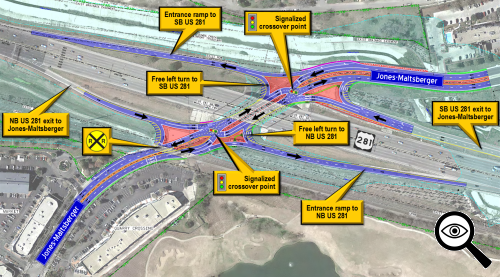|
|
|
|
|
This page last updated February 21, 2024 |

|
This project is currently in design The descriptions below are based on preliminary schematics and, as a result, details may change before the project goes to construction. This page will be updated when final schematics for the project are available. |
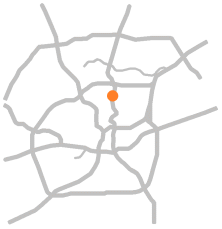
|
|

|
Location
Status
Timeline
|
|
ADVERTISEMENT |
On this page:
Project description
This approximately $5 million project will convert the intersections at US 281 at Jones-Maltsberger Rd. near the Alamo Quarry Market from conventional intersections to a "Diverging Diamond Interchange" (DDI). The DDI will shift traffic in both directions on Jones-Maltsberger to the opposite side of the roadway just before crossing US 281. Traffic will then travel under US 281 to the left of opposing traffic. This will allow traffic turning left to US 281 to then make a free left turn onto the entrance ramp. Through traffic on Jones-Maltsberger will then cross back over to the right side of the roadway. The two crossover locations will be controlled by a traffic signal. (See the diagrams below for a depiction of these changes.)
There are currently no DDIs in San Antonio, but one is under construction at Loop 1604 and Blanco, and another is proposed at SE Military Dr. and I‑37. Elsewhere in Texas, there are currently DDIs in El Paso, The Colony (north of Dallas), Round Rock, College Station, Austin, and Georgetown. The design has been used successfully in more than 100 other locations around the US as well.
A companion project is planned at the Basse Rd. interchange.
CONVENTIONAL INTERSECTION (EXISTING)
TRAFFIC FLOW FOR JONES-MALTSBERGER RD.
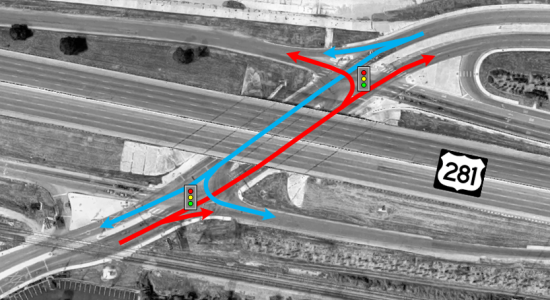
DIVERGING DIAMOND INTERSECTION (PROPOSED)
TRAFFIC FLOW FOR JONES-MALTSBERGER RD.
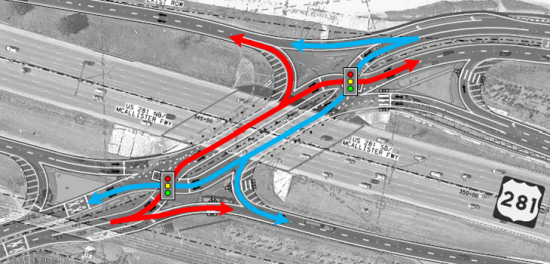
CONVENTIONAL INTERSECTION (EXISTING)
TRAFFIC FLOW FOR EXIT RAMP LEFT TURNS TO JONES-MALTSBERGER RD.
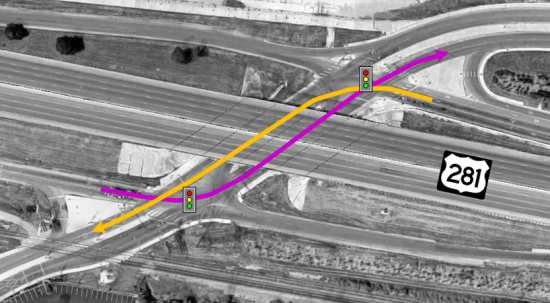
DIVERGING DIAMOND INTERSECTION (PROPOSED)
TRAFFIC FLOW FOR EXIT RAMP LEFT TURNS TO JONES-MALTSBERGER RD.
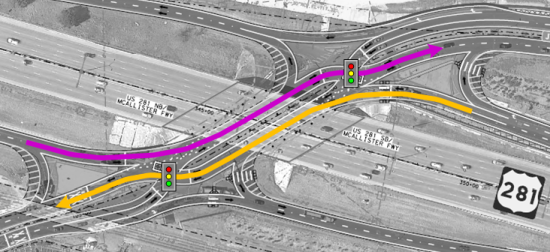
How this project will help
The DDI will help reduce current and expected future congestion at this intersection. Current and projected traffic volumes are sufficient to cause level of service "F" (congested) conditions during peak periods but are not sufficient to justify flyovers now or during the next 20 years. Thus, this intersection is considered to be in the "sweet spot" for an "outside-the-box" (no pun intended) intersection design. Computer modeling shows a dramatic improvement in this intersection's operation with a DDI over conventional improvements; the following table summarizes those findings.

DDIs also improve safety by reducing the number of potential crash points from 26 to 14 with the worst type (side-angle collisions) reduced from 10 to just two. Additionally, a DDI physically prevents drivers from turning the wrong way onto the access roads, thus helping to prevent head-on collisions.

|
For a deeper dive on how a DDI functions and how it improves traffic flow, see the Blanco Rd./Loop 1604 DDI project page. |
FAQ
- This looks confusing. It will cause lots of crashes.
While it may look complicated on the schematics, it's actually fairly easy to navigate on the ground. Statistics from DDI implementations show a significant reduction in crashes, and practical experience from other DDI locations shows drivers quickly adapt to it. - How does this improve traffic?
This intersection design improves traffic because shifting the traffic to the left side of the road through the intersections removes the conflicts between left turns and opposing traffic found in a conventional intersection. As a result, traffic in two of the four legs of the intersection can move during a single green phase instead of needing two separate phases, thus moving more traffic through the intersection in the same amount of time. - Will there be turnarounds?
No, this project will not add turnarounds. There is insufficient demand at this location for turnarounds. - Why not just add the extra turning and through lanes?
While this would help move more vehicles through the intersection on each cycle, the improvements would be short-lived as traffic increases to fill the new lanes. The DDI dramatically improves the underlying efficiency of the traffic signals themselves which provides longer-term relief. See the chart above that compares projected delay with a DDI versus conventional improvements. - Why not build flyovers instead like the ones at Bandera Rd. and Loop 410?
This intersection does not have current or projected traffic volumes or patterns to justify flyovers, and flyovers would require significant additional right-of-way. - Why don't they build a railroad overpass/underpass?
Constructing a railroad grade-separation is very expensive and requires extensive cooperation with the railroad. In this location especially, the proximity of the freeway and driveways for the nearby shopping centers makes such a project extremely challenging. That said, TxDOT and the City of San Antonio are working with Union Pacific on a long-term plan to construct grade separations for the railroad at Jones-Maltsberger, Basse, and Sunset. Such a project is likely a decade or more away, however. - How is this different than the intersection at Bandera Rd. and Loop 1604?
The DDI is similar to the Displaced Left Turn (DLT) intersection at Bandera Rd. and Loop 1604 in that they are both considered to be types of "innovative" or "alternative" intersection designs that make signalized intersections function better by removing the inefficiencies caused by protected left turns. Both intersection designs do this by moving the left turns over to the other side of the road and out of the way of oncoming traffic. However, in the DLT, it is just the left turns that are shifted to the other side of the road, whereas the DDI moves both left-turning and through traffic over. A DLT has its crossovers further away from the main intersection and requires more signals and right-of-way than a DDI. Also, the DLT does not block through-traffic on the access road like a DDI does. Finally, a DLT does not eliminate the conflicting left turns from the access roads to the cross street like a DDI does. - Who came up with this cockamamie design?
The DDI design has been used in France since the 1970s and made its debut in the United States in 2009. It is now in use in nearly 100 locations in the US and internationally and has a proven track record of improving traffic and safety wherever it has been implemented. It is one of several types of "innovative" or "alternative" intersection designs being implemented across the country at intersections that do not warrant more expensive conventional upgrades (e.g. flyovers). TxDOT selected this design for this intersection after studying multiple other options. Computer modeling showed this design provided significant improvement in operations with substantial reduction in delays. The DDI concept was hailed by Popular Science magazine as one of the top 100 innovations in 2009 and has been featured on National Public Radio and in Time, Forbes, and many other publications.
Schematic
Click on the image below to open the detailed preliminary schematics from TxDOT with my own annotations added to help clarify and explain the various elements. The schematic will open in a new window that you can scroll and zoom.
Video
TxDOT has a good video that describes this project:
Other sites of interest
|
|
TxDOT - Open House - US 281 at Basse Road and Jones Maltsberger Road Interchanges https://www.txdot.gov/ |


